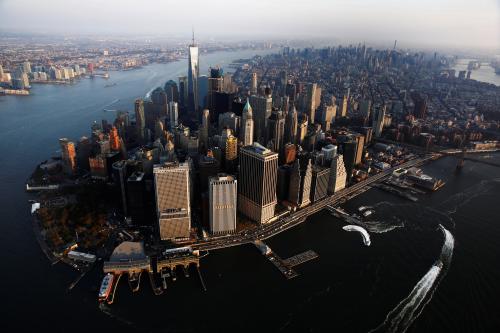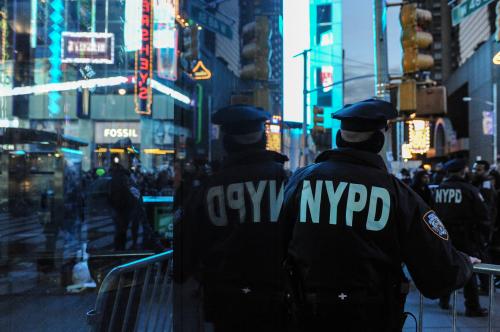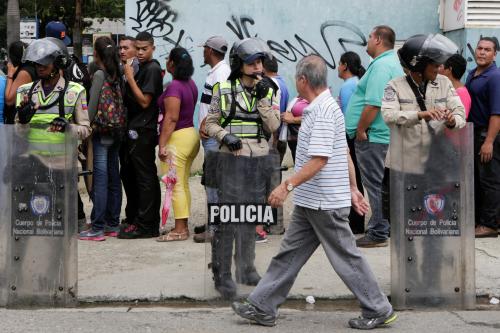On the subway a few weeks after the Madrid bombings, I noticed a parcel under a seat. I asked other passengers, but no one claimed the object. I looked inside the parcel and saw some papers and an elaborately wrapped object the size of a grapefruit. The train pulled into Metro Center, the main station of the Washington subway. I contemplated that I might be about to pick up a bomb, but then I’d already been stupid enough to look inside, so I carried out the package, put it on a bench and told the station manager. Officers appeared quickly, though trains continued running and people kept milling past.
When I first saw the package, should I have used the emergency intercom to alert the motorman? Should he have stopped the train and evacuated everyone? When I alerted the manager, should she have closed the station, bringing the entire system to a halt? Had it turned out to be a bomb, pundits second-guessing the disaster that followed might have said the station manager and I were fools for not pushing the panic button. But what if a trainload of frantic people had been evacuated into a dark tunnel with a high-voltage rail, all because of an elaborately wrapped grapefruit?
This is an example of the practical limits to security in the post-9/11 world. With the introduction of sophisticated airport inspections, bomb-screening of checked bags, security stops at building entrances, better passport controls, “smart borders” with improved computers and identity scanners, and hundreds of radiation and bioweapon detectors installed in urban areas, security has significantly improved in just three years. This summer, residents of New York and Boston are seeing lots of extra patrols, bomb-sniffing dogs and police drills, in preparation for the political conventions.
But some of what’s being done is primarily psychological: to make people feel more safe, regardless of whether they really are. And though the government must try any reasonable idea to counter terrorism, in the next round of security improvements to come there will be serious limits to practicality and affordability.
Consider train safety. Recently the Transportation Security Administration tested screening of Amtrak passengers at the New Carrollton, Md., stop. Riders walked one by one through a device that sniffs the air for molecules associated with explosives. Probably anyone carrying a bomb would have been detected. But Amtrak has about 500 stations, half unstaffed whistle-stops. To add bomb-sniffers, plus personnel, to every station would be a significant expense.
The New Carrollton stop is a quiet suburban station handling roughly 1,000 passengers a day. The Washington subway system carries half a million passengers a day. Many enter at downtown stations that are mob scenes; to make everyone walk through sniffer machines would be incredibly cumbersome. The New York subway system carries 3.8 million passengers a day, boarding at 468 stations. Screening all those riders would be a logistical nightmare, even if cost were no object. Many New York stations would need extensive re-engineering, and the lines would stretch up the stairs.
And cost is an object. An estimated $11 billion has been spent to improve American airline security since Sept. 11, 2001. The airlines board about 1.5 million passengers a day. With the New York subway system alone carrying more than twice that, screening might cost about twice as much as has been spent on airline security.
Maybe there’s a way to avoid subway passenger screening. Starting in July, Boston transit police will hand-search the packages of travelers on the storied T subway system. Riders will continue to board unscreened. Officers, some with explosives-sniffing dogs, will wander through cars and demand that passengers open packages, briefcases or backpacks. Already there is an excruciating legal dispute about whether the officers should be scanning for those who fit terrorist profiles, or making random searches: that is, ordering grandma to show what’s in her purse while ignoring the Middle Eastern-looking young man with the backpack.
Set aside the legalities and concentrate on the practical. The Boston system has 247 transit officers, only a fraction of whom will be on trains at any particular time. What are the odds officers will stumble onto the one person, among hundreds of thousands, who is carrying something dangerous?
People will feel safer knowing that officers are there, and making people feel safer may be the next best thing to actual safety. In the months after 9/11, National Guard units in battle fatigues patrolled airports: those camouflage outfits would hardly have helped Guard members blend in against a backdrop of vacationers and Chick-Fil-A stands. Officers with assault rifles now walk Times Square, though the chances an assault rifle will be needed are slim.
Amtrak now demands that ticket buyers show a driver’s license or similar identification. Maybe this will catch a lone deranged person, but the 9/11 attackers made sure their paperwork was in order. Many office buildings now require visitors to show a driver’s license, which a low-wage desk worker glances at perfunctorily. During the Democratic National Convention in July, the police will close much of the highway system of downtown Boston.
How much has been spent on real action? Steven M. Kosiak, an analyst at the Center for Strategic and Budgetary Assessments, a Washington research group, estimates that since Sept. 11, 2001, about $26 billion has been invested in improving the security of critical infrastructure in the United States. Domestic security over all (personnel and preparedness as well as infrastructure) is a $41.3 billion line in the current federal budget, and President Bush has requested $47.4 billion in fiscal 2005, a request that includes allotments like $3.6 billion to stockpile vaccines and antidotes. Domestic antiterrorism spending is now at nearly 10 times the level of President Bill Clinton’s final budget for it. Nonetheless, last year a Council on Foreign Relations report said domestic security was drastically underfinanced.
Senator John Kerry, the presumptive Democratic presidential nominee, says he wants still higher spending. He advocates 100,000 more firefighters, 5,000 new police officers trained specifically for antiterrorism, special funds for states and cities whenever an orange-level security alert is issued and other new investments.
But money for more security must be weighed against other priorities. The Council on Foreign Relations study, for example, noted, “Only 10 percent of fire departments in the United States have the personnel and equipment to respond to a building collapse.” Yet should most fire departments have millions of dollars’ worth of equipment to handle a building collapse, when the chances of this happening in any one place, even any one big city, are tiny?
Further improvements in security may prove impractical, or threats to liberty. Should bus passengers be screened? Israel, that most security-conscious of nations, has found bus attacks nearly impossible to stop. Should all cars be inspected before entering parking garages? The first World Trade Center attack involved a van bomb in the parking garage. (Cars entering the parking lots at many federal buildings are now inspected; this is not done at most commercial lots under private skyscrapers.) Should everyone carry an identity card with “biometric” data coded into it? The economic considerations are just as daunting. Mr. Kosiak estimates $407 billion has been spent in the wake of 9/11, a figure that includes military operations in Afghanistan and Iraq. If the estimate is correct, then more than 1 percent of the gross domestic product since 9/11 has gone to security improvements and to the wars in Iraq and Afghanistan. National prosperity has declined slightly as a result.
Extra security layers also burden the economy. Roadblocks slow the movement of goods; complex inspections of shipments add to processing costs; restricting entry to the United States of the 99.9999 percent of foreign citizens who mean no harm is bad for tourism, for movement of intellectual capital and other aspects of the economy. One reason America has prospered is that it invested heavily in removing friction from the economy by making trade, travel and transactions as convenient as possible. Since 9/11, “we’ve been putting the friction back in,” Brian Michael Jenkins of the RAND Corporation has noted.
Consider movement of shipping. Some 20,000 shipping containers a day arrive at United States ports, with perhaps 1 percent inspected. An estimated 250 million shipping containers are in motion around the world. The Central Intelligence Agency is believed to have concluded that a crude atomic bomb or other terror weapon is far more likely to arrive in the United States via shipping container than on a missile from a rogue state.
But 20,000 shipping containers per day cannot be fully inspected without significantly slowing the economy. The Department of Homeland Security has a program to place American inspectors overseas at ports like Rotterdam and Singapore. But there’s a practical limit to how secure shipping can be, just as there are practical limits to many ideas to improve security.
In a world of six billion souls, all it takes is one person a day willing to commit suicide to cause harm and sustain the sense of civilization in jeopardy. Governments will keep trying to improve public safety, but no matter how much is spent, there may be a limit to buying security against that one person.



Commentary
In an Age of Terror, Safety Is Relative
June 27, 2004